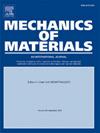具有应力效应的温度梯度驱动固体扩散的本构模型
IF 3.4
3区 材料科学
Q2 MATERIALS SCIENCE, MULTIDISCIPLINARY
引用次数: 0
摘要
在温度梯度存在的情况下,溶质原子的不均匀再分布通常发生在最初均匀的固体中,如燃气轮机叶片中合金元素的偏析,这种现象被称为路德维希-索莱特效应。溶质原子在固体中的重分配过程伴随着显著的应力,这在以往的理论中没有考虑到。在不可逆热力学的框架下,建立了温度梯度驱动扩散的本构模型。研究了溶质原子的重分布过程和应力的影响。结果表明,所建立的模型描述了溶质原子的重分布规律,阐明了其隐含的机理。溶质原子的重分布首先从热端开始,逐渐向冷端延伸。应力延缓了由温度梯度驱动的扩散,从而降低了溶质原子的不均匀再分布。此外,所获得的定量关系预测了形成的浓度梯度的方向和大小。根据我们的研究结果,研究人员可以优化元素的分布和评估工程材料的使用性能。本文章由计算机程序翻译,如有差异,请以英文原文为准。
A constitutive model of temperature gradient driving diffusion in solids with stress effect
In the presence of temperature gradient, the non-uniform redistribution of solute atom usually occurs in an initially uniform solid, e.g. the segregation of alloy element in the gas turbine blade, and this phenomenon is called as Ludwig-Soret effect. The redistribution process of solute atom accompanies a significant stress in solids, which was not taken into account in previous theories. In this paper, in the framework of the irreversible thermodynamics, we establish a constitutive model of temperature gradient driving diffusion. The redistribution process of solute atom and the effect of stress are investigated, respectively. The results reveal that our established model describes the redistribution law of solute atom and clarifies the implied mechanism. And the redistribution of solute atom firstly starts at the hot end and gradually extends towards the cold end. Stress retards the diffusion driven by the temperature gradient and then reduces the non-uniform redistribution of solute atom. Moreover, the obtained quantitative relationship predicts the direction and magnitude of the formed concentration gradient. According to our results, researchers can optimize the distribution of element and evaluate the service performance of engineering materials.
求助全文
通过发布文献求助,成功后即可免费获取论文全文。
去求助
来源期刊

Mechanics of Materials
工程技术-材料科学:综合
CiteScore
7.60
自引率
5.10%
发文量
243
审稿时长
46 days
期刊介绍:
Mechanics of Materials is a forum for original scientific research on the flow, fracture, and general constitutive behavior of geophysical, geotechnical and technological materials, with balanced coverage of advanced technological and natural materials, with balanced coverage of theoretical, experimental, and field investigations. Of special concern are macroscopic predictions based on microscopic models, identification of microscopic structures from limited overall macroscopic data, experimental and field results that lead to fundamental understanding of the behavior of materials, and coordinated experimental and analytical investigations that culminate in theories with predictive quality.
 求助内容:
求助内容: 应助结果提醒方式:
应助结果提醒方式:


